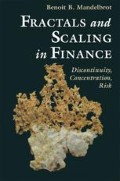Abstract
This long and essential chapter provides this book with two of its multiple alternative introductions. The mathematically ambitious reader who will enter here will simply glance through Section 1, which distinguishes between self-similarity and self-affinity, and Section 2, which is addressed to the reader new to fractals and takes an easy and very brief look at self-similarity. Later sections approach subtle and diverse facets of self-affine scaling from two distinct directions, each with its own significant assets and liabilities.
Section 3 begins with WBM, the Wiener Brownian motion. In strict adherence to the scaling principle of economics described in Chapter E2, WBM is self-affine in a statistical sense. This is true with respect to an arbitrary reduction ratio r, and there is no underlying grid, hence WBM can be called the grid free. Repeating in more formal terms some material in Sections 6 to 8 of Chapter El, Section 3 discusses generalizations that share the scaling properties of WBM, namely, Wiener or fractional Brownian motion of fractal or multifractal time.
Section 4 works within grids, hence limits the reduction ratio r to certain particular values. Being grid-bound weakens the scaling principle of economics, but this is the price to pay in exchange for a significant benefit, namely the availability of a class of self-affine non-random functions whose patterns of variability include and exceed those of Section 3. Yet, those functions fall within a unified overall master structure. They are simplified to such an extent that they can be called “toy models” or “cartoons.”
The cartoons are grid-bound because they are constructed by recursive multiplicative interpolation, proceeding in a self-affine grid that is the sim?plest case prescribed in advance. The value of grid-bound non-random fractality is that it proves for many purposes to be an excellent surrogate for randomness. The properties of the models in Section 3 can be reproduced with differences that may be viewed as elements of either indeterminacy or increased versatility. Both the close relations and the differences between the cartoons could have been baffling, but they are pinpointed immediately by the enveloping master structure. At some cost, that structure can be randomly shuffled or more deeply randomized. Its overall philosophy also suggests additional implementations, of which some are dead-ends, but others deserve being explored.
Wiener Brownian motion and its cartoons belong to the mild state of variability or noisiness, while the variability or noisiness of other functions of Section 3 and cartoons of Section 4 are wild. The notions of states of mild and wild randomness, as put forward in Chapter E5, are generalized in Section 5 from independent random variables to dependent random processes and non-random cartoons. Section 5.4 ends by describing an ominous scenario of extraordinary wildness.
Being constrained to scaling functions, this chapter leaves no room for slow variability.
Access this chapter
Tax calculation will be finalised at checkout
Purchases are for personal use only
Preview
Unable to display preview. Download preview PDF.
Author information
Authors and Affiliations
Rights and permissions
Copyright information
© 1997 Springer Science+Business Media New York
About this chapter
Cite this chapter
Mandelbrot, B.B. (1997). Self-similarity and panorama of self-affinity. In: Fractals and Scaling in Finance. Springer, New York, NY. https://doi.org/10.1007/978-1-4757-2763-0_6
Download citation
DOI: https://doi.org/10.1007/978-1-4757-2763-0_6
Publisher Name: Springer, New York, NY
Print ISBN: 978-1-4419-3119-1
Online ISBN: 978-1-4757-2763-0
eBook Packages: Springer Book Archive

